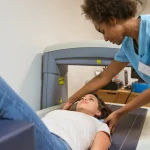Hormone therapy to relieve symptoms of menopause was a mainstay of medical treatment for menopause from the 1960’s until 2002. Even though the treatment was widespread, prior to the late 90’s, no clinical research had been done to understand the impact of hormone therapy (HT) on women’s health, despite its prevalence.
When clinical research was finally undertaken in the late 90’s and early 2000’s, prescribing hormones to menopausal women stopped dead in its tracks since the preliminary outcome of the first two clinical trials showed that hormone therapy had more detrimental than beneficial effects.
Because of these results, an entire generation of women have gone without the benefit of Menopause Hormone Therapy (MHT). However, a new focus on women’s health and reanalysis of trials have shed light on the benefits of MHT, particularly for early perimenopausal women, offering hope for some women moving forward.
What is Menopause Hormone Therapy?
Menopause hormone therapy focuses on supplementing the hormones that decrease during the menopause process. There are two main types of MHT:
- Systemic
Systemic hormones circulate throughout the bloodstream and to all parts of the body. They are available as an oral tablet, patch, gel, emulsion, spray, or injection and can be used for hot flashes and night sweats, vaginal symptoms, and osteoporosis.
- Local (nonsystemic)
These products affect only a specific or localized area of the body. They are available as a cream, ring, or tablet and are mainly used for vaginal symptoms.
If your uterus is intact, your doctor will typically prescribe estrogen along with progesterone or progestin (progesterone-like medication). This is because estrogen alone, when not balanced by progesterone, can stimulate growth of the lining of the uterus, increasing the risk of endometrial cancer.
Insider Tip: Menopause hormone therapy (MHT) and hormone replacement therapy (HRT) are both hormone therapies that treat different situations. HRT is prescribed for reasons not due to menopause (e.g. hysterectomy) while MHT refers to hormone supplementation to help relieve symptoms of menopause.
Benefits and Risks of Menopause Hormone Therapy
Since 2002, many clinical studies have shown that systemic hormone therapy (estrogen with or without progestin) can help with symptoms such as hot flashes, vaginal dryness, night sweats, bone loss, and have also been shown to improve mood and cognition.
However, there are serious health risks to know about when considering MHT. These include heart disease, stroke, blood clots and breast cancer along with increased risk of vaginal bleeding, urinary incontinence, and dementia.
These risks vary according to:
- Age. Women who begin HT who are 60 years of age or older or more than 10 years from the onset of menopause are at greater risk of the above conditions. But if hormone therapy is started before the age of 60 or within 10 years of menopause, the benefits appear to outweigh the risks.
- Type of hormone therapy. The risks are also dependent upon whether estrogen is given alone or with progestin, and on the dose and type of estrogen.
- Health history. Your family history and your personal medical history are important factors in determining whether MHT is appropriate for you.
Depending on the woman’s health profile, MHT may be recommended at the lowest effective dose for the shortest period. The deeper concern about the safety of hormone treatment is with long-term use of systemic therapies.
Bioidentical Hormones
Bioidentical hormones have gotten a lot of press recently, so some women are opting for them over synthetic hormones. Bioidentical hormones are derived from plant sources and have a chemical structure identical to hormones naturally produced by the body.
While some claim that bioidentical hormones are safer and more effective than traditional hormone therapy, there is no scientific evidence supporting these claims.
Additionally, compounded bioidentical hormones are an area of concern for healthcare providers. Misinformation has spread the word that they are just as effective as Health Canada approved hormone therapy. However, there can be inconsistencies in the quantities of estradiol and other estrogen preparations in compounded preparations along with concerns about safety, effectiveness, and quality control.
Menopause is becoming big business and misinformation on the internet abounds, so be prudent when choosing a healthcare provider and treatments for your symptoms. Read our article about menopause and finding a qualified menopause practitioner in Canada to be sure you get the best guidance.
Cost
Hormone therapy in Canada is an out-of-pocket expense. Depending on the product you are taking, you should expect to spend at least $50 or more a month. Bioidentical hormone therapy costs anywhere from $50 to upwards of $250 per month.
If you have private insurance, you may be reimbursed for some of the expense. Check with your insurance provider for details.
Menopause hormone therapy may be a great solution for you depending on your personal health profile. Experts agree that there is still much to learn about safely integrating hormone therapy into treatment for menopause.
If you aren’t able to take advantage of MHT, rest assured that many other options exist to help you through this important time of life.
As your needs change and evolve, new hormone therapies and guidelines may become available. Make sure you work with your menopause healthcare provider to reevaluate and adjust your individualized treatment as your situation changes.
Subscribe today to The Health Insider to stay up to date on advancements in menopause care.
~ Read more from The Health Insider ~
- Post-Menopause and Dealing with Recurrent UTI’s? These New Options Could Change EverythingRecurrent UTI’s are more common after menopause. Learn why this is, which treatments actually help and more on the new vaccine that’s in the works.
- Your Gut’s in Menopause Too: The Surprising Link Between Hormones, Digestion and Your SanityThe hormonal shifts that take place during menopause change a lot in your body – including disrupting your microbiome. Here’s how to restore gut health from within.
- Endometriosis Care in Canada: Get Diagnosed and Find the Experts Who Can HelpEndometriosis affects 1 in 10 Canadian women, but navigating care can be challenging. Here’s how to advocate for yourself and find the right treatment.
- Maternal Mental Health: New Study Supports Expanding Ways To Get HelpOne in five Canadian pregnant and postpartum women experience depression and anxiety, but fewer than 10% receive proper treatment. A new study shows effective ways to expand access.
- Ignored Risk: Bone Scans For People Over 50A fall, a fracture, and an unexpected diagnosis: learn how osteoporosis can strike silently and how to protect your bones.
- Thriving in Your Sex Life During MenopauseMenopause can shift sexual health, but open communication and self-care can enhance intimacy and joy in this life stage.
The information provided on TheHealthInsider.ca is for educational purposes only and does not substitute for professional medical advice. TheHealthInsider.ca advises consulting a medical professional or healthcare provider when seeking medical advice, diagnoses, or treatment. To read about our editorial review process click here.

















